fuel Lancia Delta 2015 Owner handbook (in English)
[x] Cancel search | Manufacturer: LANCIA, Model Year: 2015, Model line: Delta, Model: Lancia Delta 2015Pages: 291, PDF Size: 6.74 MB
Page 188 of 291
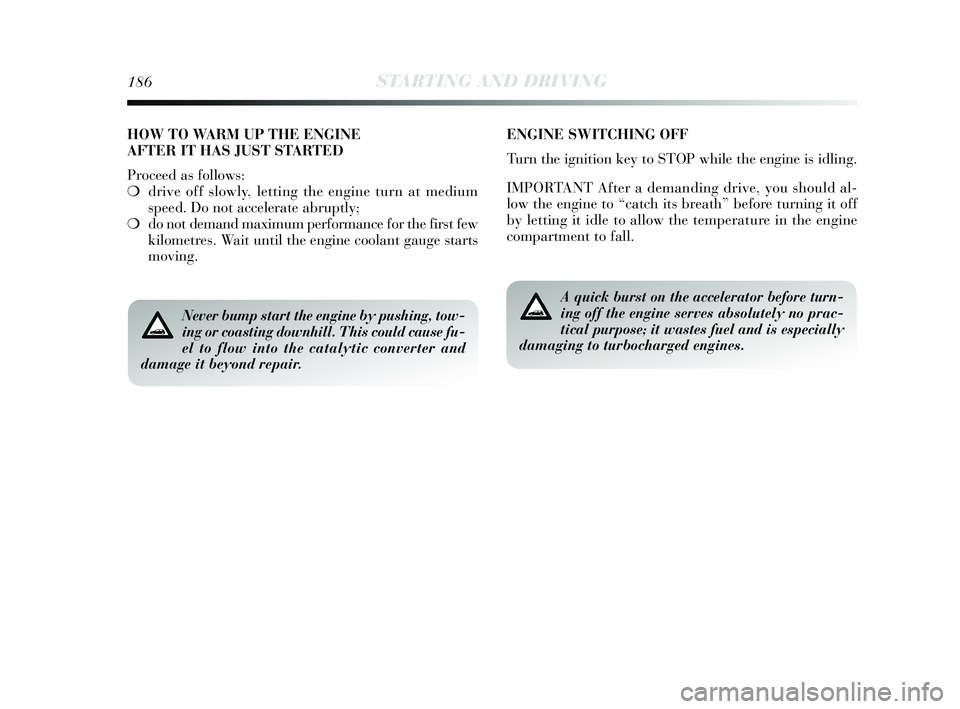
186STARTING AND DRIVING
Never bump start the engine by pushing, tow-
ing or coasting downhill. This could cause fu-
el to flow into the catalytic converter and
damage it beyond repair.
HOW TO WARM UP THE ENGINE
AFTER IT HAS JUST STARTED
Proceed as follows:
❍ drive off slowly, letting the engine turn at medium
speed. Do not accelerate abruptly;
❍ do not demand maximum performance for the first few
kilometres. Wait until the engine coolant gauge starts
moving. ENGINE SWITCHING OFF
Turn the ignition key to STOP while the engine is idling.
IMPORTANT After a demanding drive, you should al-
low the engine to “catch its breath” before turning it off
by letting it idle to allow the temperature in the engine
compartment to fall.
A quick burst on the accelerator before turn-
ing off the engine serves absolutely no prac-
tical purpose; it wastes fuel and is especially
damaging to turbocharged engines.
183-194 Delta GB 1ed 26/08/13 12.15 Pagina 186
Page 191 of 291
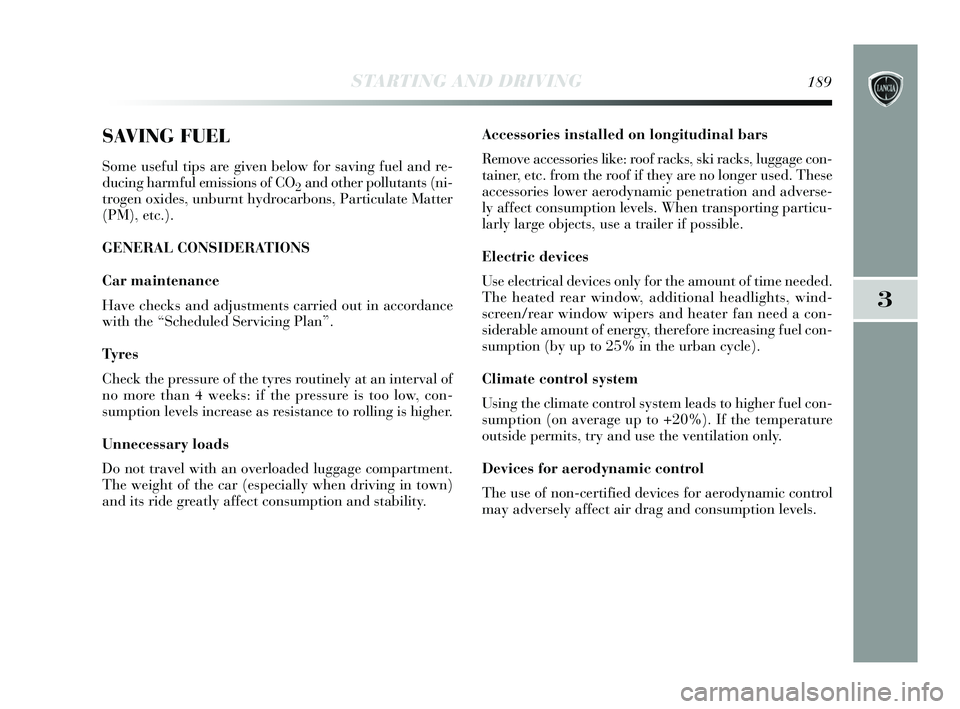
STARTING AND DRIVING189
3
SAVING FUEL
Some useful tips are given below for saving fuel and re-
ducing harmful emissions of CO
2and other pollutants (ni-
trogen oxides, unburnt hydrocarbons, Particulate Matter
(PM), etc.).
GENERAL CONSIDERATIONS
Car maintenance
Have checks and adjustments carried out in accordance
with the “Scheduled Servicing Plan”.
Ty r e s
Check the pressure of the tyres routinely at an interval of
no more than 4 weeks: if the pressure is too low, con-
sumption levels increase as resistance to rolling is higher.
Unnecessary loads
Do not travel with an overloaded luggage compartment.
The weight of the car (especially when driving in town)
and its ride greatly affect consumption and stability. Accessories installed on longitudinal bars
Remove accessories like: roof racks, ski racks, luggage con-
tainer, etc. from the roof if they are no longer used. These
accessories lower aerodynamic penetration and adverse-
ly affect consumption levels. When transporting particu-
larly large objects, use a trailer if possible.
Electric devices
Use electrical devices only for the amount of time needed.
The heated rear window, additional headlights, wind-
screen/rear window wipers and heater fan need a con-
siderable amount of energy, therefore increasing fuel con-
sumption (by up to 25% in the urban cycle).
Climate control system
Using the climate control system leads to higher fuel con-
sumption (on average up to +20%). If the temperature
outside permits, try and use the ventilation only.
Devices for aerodynamic control
The use of non-certified devices for aerodynamic control
may adversely affect air drag and consumption levels.
183-194 Delta GB 1ed 26/08/13 12.15 Pagina 189
Page 192 of 291

190STARTING AND DRIVING
DRIVING STYLE
Cranking
Do not warm up the engine at low or high revs when the
car is stationary: under these conditions the engine warms
up much more slowly, increasing consumption and emis-
sions. It is therefore advisable to move off immediately,
slowly, avoiding high speeds: in this way the engine will
warm up more quickly.
Unnecessary actions
Avoid revving up when at traffic lights or before stopping
the engine. The latter action, like double-declutching, is
completely unnecessary and causes increased fuel con-
sumption and pollution.
Gear selection
As soon as the conditions of the traffic and road permit,
use a higher gear. Using a low gear for faster accelera-
tion will increase consumption.
In the same way improper use of a high gear increases con-
sumption, emissions and engine wear.
Max. speed
Fuel consumption considerably increases as speed in-
creases. Maintain a constant speed, avoiding unnecessary
braking and acceleration, which cost in terms of both fu-
el consumption and emissions.Acceleration
Accelerating violently will greatly affect consumption and
emissions: acceleration should be gradual.
CONDITIONS OF USE
Cold starting
Short journeys and frequent cold starts do not allow the
engine to reach optimum operating temperature. This re-
sults in a significant increase in consumption levels (from
+15 to +30% on the urban cycle) and emissions.
Traffic and road conditions
Rather high fuel consumption is caused by heavy traffic,
for instance when travelling in a queue with frequent use
of low gears or in large towns with many traffic lights.
Mountain and rough roads also have a negative effect on
fuel consumption.
Stops in traffic
During prolonged stops (e.g. level crossings) the engine
should be switched off.
183-194 Delta GB 1ed 26/08/13 12.15 Pagina 190
Page 198 of 291

196IN AN EMERGENCY
STARTING THE ENGINE
Go to a Lancia Dealership immediately if instrument pan-
el
Ywarning light remains on constantly.
JUMP STARTING fig. 1
If the battery is flat, the engine may be started using an
auxiliary battery with the same capacity or a little high-
er than the flat one.
fig. 1L0E0074m
Strictly avoid using a rapid battery charger
for jump starting: this could damage the elec-
tronic systems and the engine fuel supply and
ignition control units.
This starting procedure must be carried out
by expert personnel as incorrect manoeuvres
can cause electrical discharges of consider-
able intensity. Furthermore, battery fluid is poiso-
nous and corrosive: avoid contact with skin and
eyes. Keep naked flames away from the battery. No
smoking. Do not cause sparks.
195-232 Delta GB 1ed 03/03/14 09.14 Pagina 196
Page 199 of 291

IN AN EMERGENCY197
4
Proceed as follows to start the car:
❍connect the positive terminals (+ sign close to the ter-
minal) of both batteries using a lead;
❍ with a second lead, connect the negative terminal –
of the auxiliary battery to an earthing point E
on the
engine or the gearbox of the car to be started;
❍ start the engine;
❍ when the engine has been started, follow the sequence
above in reverse order to remove the leads.
If after a few attempts the engine does not start, do not
persist but contact a Lancia Dealership.
IMPORTANT Do not directly connect the negative ter-
minals of the two batteries: any sparks may ignite the ex-
plosive gas which could come out of the battery. If the aux-
iliary battery is installed on another car, prevent any con-
tact between metal parts of the two cars. BUMP STARTING
Never bump start the engine by pushing, towing or coast-
ing downhill.
This could cause fuel to flow into the catalytic converter
and damage it beyond repair.
IMPORTANT Remember that the brake servo and elec-
trical power steering system (where provided) are not op-
erational until the engine is started, a greater effort will
therefore be required to press the brake pedal or turn the
steering wheel.
195-232 Delta GB 1ed 03/03/14 09.14 Pagina 197
Page 229 of 291
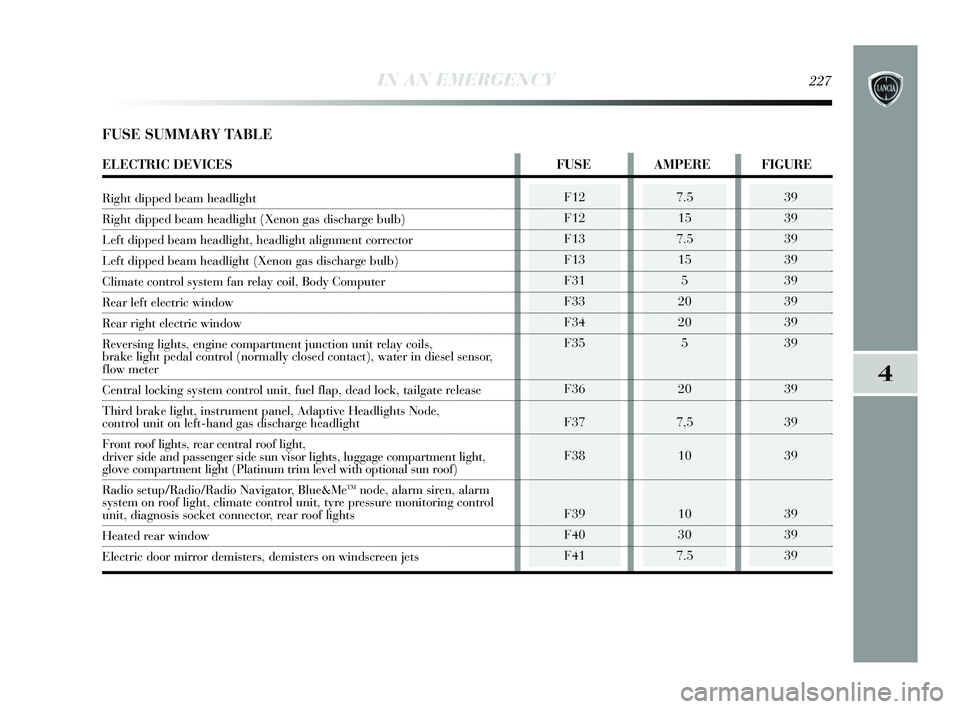
IN AN EMERGENCY227
4
F12
F12
F13
F13
F31
F33
F34
F35
F36
F37
F38
F39
F40
F417.515
7.5 15 5
20
20 5
20
7,5 10
10
30
7.539
39
39
39
39
39
39
39
39
39
39
39
39
39
FUSE SUMMARY TABLE
ELECTRIC DEVICES FUSE AMPERE FIGURE
Right dipped beam headlight
Right dipped beam headlight (Xenon gas discharge bulb)
Left dipped beam headlight, headlight alignment corrector
Left dipped beam headlight (Xenon gas discharge bulb)
Climate control system fan relay coil, Body Computer
Rear left electric window
Rear right electric window
Reversing lights, engine compartment junction unit relay coils,
brake light pedal control (normally closed contact), water in diesel sensor,
flow meter
Central locking system control unit, fuel flap, dead lock, tailgate release
Third brake light, instrument panel, Adaptive Headlights Node,
control unit on left-hand gas discharge headlight
Front roof lights, rear central roof light,
driver side and passenger side sun visor lights, luggage compartment lig\
ht,
glove compartment light (Platinum trim level with optional sun roof)
Radio setup/Radio/Radio Navigator, Blue&Me
TMnode, alarm siren, alarm
system on roof light, climate control unit, tyre pressure monitoring control
unit, diagnosis socket connector, rear roof lights
Heated rear window
Electric door mirror demisters, demisters on windscreen jets
195-232 Delta GB 1ed 03/03/14 09.15 Pagina 227
Page 231 of 291
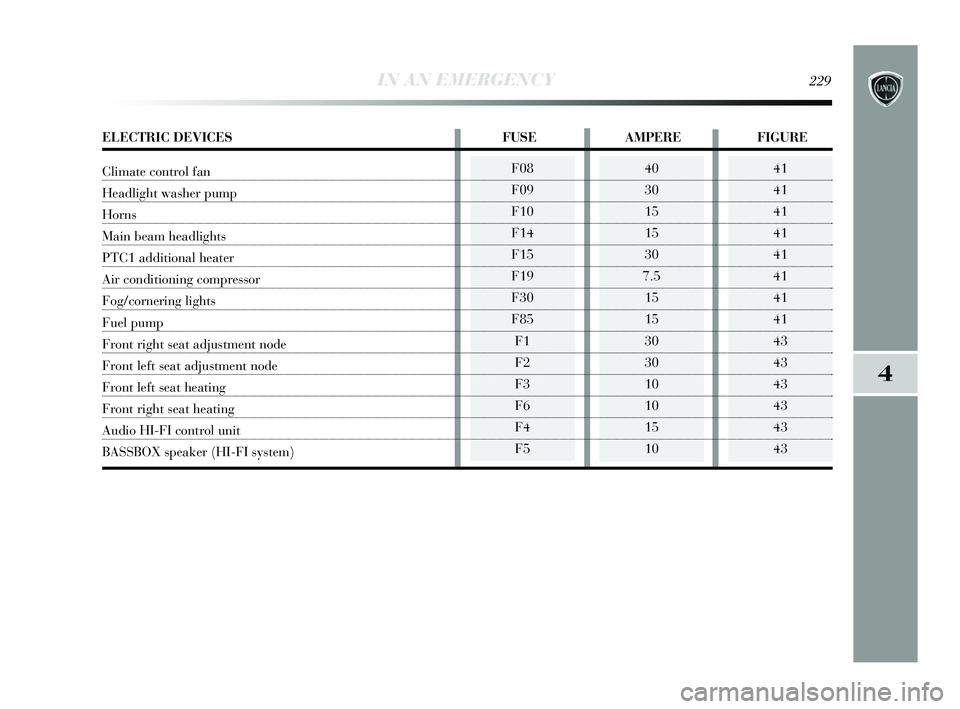
IN AN EMERGENCY229
4
F08
F09
F10
F14
F15
F19
F30
F85F1
F2
F3
F6
F4
F540
30
15
15
30
7.5 15
15
30
30
10
10
15
1041
41
41
41
41
41
41
41
43
43
43
43
43
43
ELECTRIC DEVICES FUSEAMPERE FIGURE
Climate control fan
Headlight washer pump
Horns
Main beam headlights
PTC1 additional heater
Air conditioning compressor
Fog/cornering lights
Fuel pump
Front right seat adjustment node
Front left seat adjustment node
Front left seat heating
Front right seat heating
Audio HI-FI control unit
BASSBOX speaker (HI-FI system)
195-232 Delta GB 1ed 03/03/14 09.15 Pagina 229
Page 237 of 291
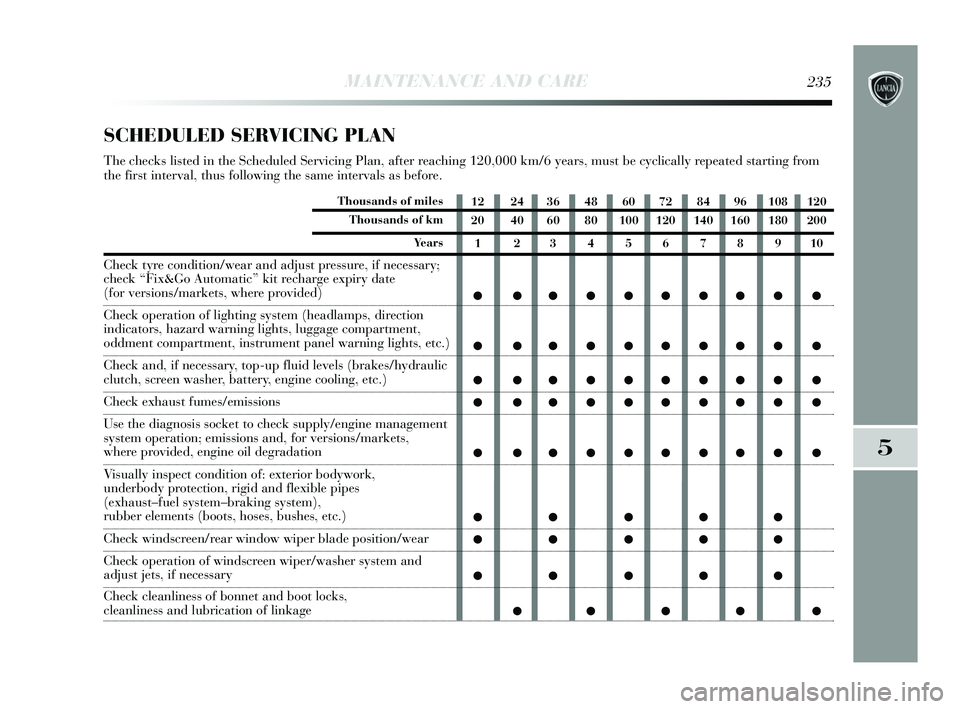
MAINTENANCE AND CARE235
5
12 24 36 48 60 72 84 96 108 120
20 40 60 80 100 120 140 160 180 2001 2345678910
â—Ź â—Źâ—Źâ—Źâ—Źâ—Źâ—Źâ—Źâ—Ź â—Ź
â—Ź â—Źâ—Źâ—Źâ—Źâ—Źâ—Źâ—Źâ—Ź â—Ź
â—Ź â—Źâ—Źâ—Źâ—Źâ—Źâ—Źâ—Źâ—Ź â—Ź
â—Ź â—Źâ—Źâ—Źâ—Źâ—Źâ—Źâ—Źâ—Ź â—Ź
â—Ź â—Źâ—Źâ—Źâ—Źâ—Źâ—Źâ—Źâ—Ź â—Ź
â—Ź â—Ź â—Źâ—Źâ—Ź
â—Ź â—Ź â—Źâ—Źâ—Ź
â—Ź â—Ź â—Źâ—Źâ—Ź â—Źâ—Źâ—Źâ—Ź â—Ź
SCHEDULED SERVICING PLAN
The checks listed in the Scheduled Servicing Plan, after reaching 120,000 km/6 years, must be cyclically repeated starting from
the first interval, thus following the same intervals as before.
Thousands of miles
Thousands of km
Years
Check tyre condition/wear and adjust pressure, if necessary;
check “Fix&Go Automatic” kit recharge expiry date
(for versions/markets, where provided)
Check operation of lighting system (headlamps, direction
indicators, hazard warning lights, luggage compartment,
oddment compartment, instrument panel warning lights, etc.)
Check and, if necessary, top-up fluid levels (brakes/hydraulic
clutch, screen washer, battery, engine cooling, etc.)
Check exhaust fumes/emissions
Use the diagnosis socket to check supply/engine management
system operation; emissions and, for versions/markets,
where provided, engine oil degradation
Visually inspect condition of: exterior bodywork,
underbody protection, rigid and flexible pipes
(exhaust–fuel system–braking system),
rubber elements (boots, hoses, bushes, etc.)
Check windscreen/rear window wiper blade position/wear
Check operation of windscreen wiper/washer system and
adjust jets, if necessary
Check cleanliness of bonnet and boot locks,
cleanliness and lubrication of linkage
233-256 Delta GB 1ed 03/04/14 13:27 Pagina 235
Page 238 of 291
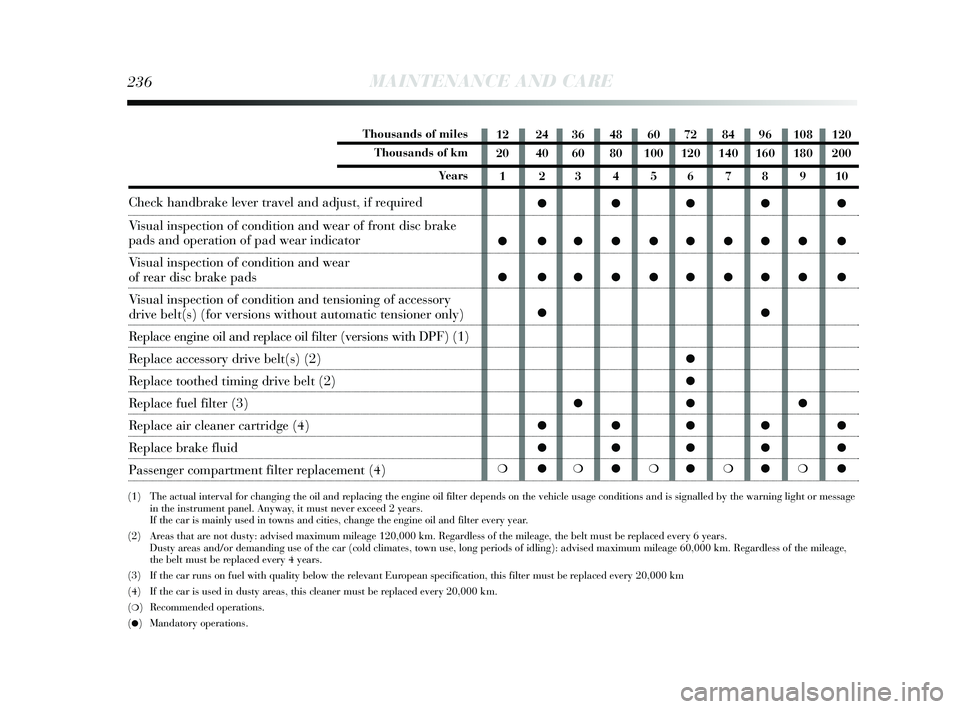
236MAINTENANCE AND CARE
12 24 36 48 60 72 84 96 108 120
20 40 60 80 100 120 140 160 180 2001 2345678910
â—Źâ—Źâ—Źâ—Ź â—Ź
â—Ź â—Źâ—Źâ—Źâ—Źâ—Źâ—Źâ—Źâ—Ź â—Ź
â—Ź â—Źâ—Źâ—Źâ—Źâ—Źâ—Źâ—Źâ—Ź â—Ź â—Źâ—Ź
â—Ź
â—Ź
â—Źâ—Źâ—Ź
â—Źâ—Źâ—Źâ—Ź â—Ź
â—Źâ—Źâ—Źâ—Ź â—Ź
❍ ●❍●❍●❍●❍ ●
(1) The actual interval for changing the oil and replacing the engine oil filter depends on the vehicle usage conditions a\
nd is signalled by the warning light or message
in the instrument panel. Anyway, it must never exceed 2 years.
If the car is mainly used in towns and cities, change the engine oil and\
filter every year.
(2) Areas that are not dusty: advised maximum mileage 120,000 km. Regardless of the mileage, the belt must be replaced every 6 y ears.
Dusty areas and/or demanding use of the car (cold climates, town use, long peri\
ods of idling): advised maximum mileage 60,000 k m. Regardless of the mileage,
the belt must be replaced every 4 years.
(3) If the car runs on fuel with quality below the relevant European specification, this filter must be replaced every 20,000 km
(4) If the car is used in dusty areas, this cleaner must be replaced every 20,000 km.
(
❍) Recommended operations.
(
â—Ź) Mandatory operations.
Thousands of miles
Thousands of km
Years
Check handbrake lever travel and adjust, if required
Visual inspection of condition and wear of front disc brake
pads and operation of pad wear indicator
Visual inspection of condition and wear
of rear disc brake pads
Visual inspection of condition and tensioning of accessory
drive belt(s) (for versions without automatic tensioner only)
Replace engine oil and replace oil filter (versions with DPF) (1)
Replace accessory drive belt(s) (2)
Replace toothed timing drive belt (2)
Replace fuel filter (3)
Replace air cleaner cartridge (4)
Replace brake fluid
Passenger compartment filter replacement (4)
233-256 Delta GB 1ed 03/04/14 13:27 Pagina 236
Page 240 of 291
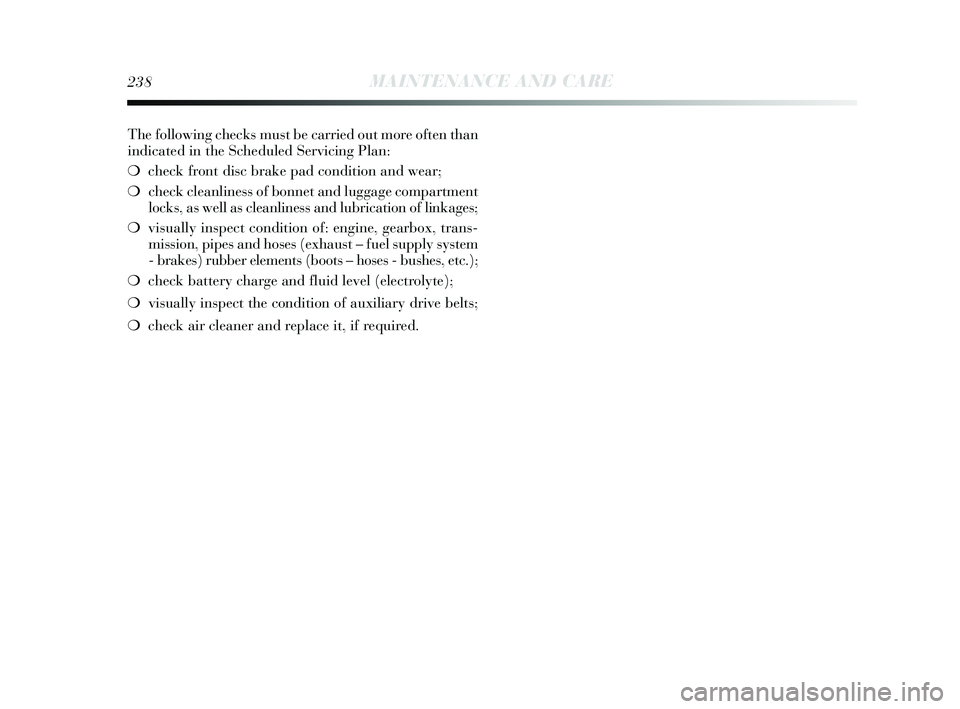
The following checks must be carried out more often than
indicated in the Scheduled Servicing Plan:
❍check front disc brake pad condition and wear;
❍ check cleanliness of bonnet and luggage compartment
locks, as well as cleanliness and lubrication of linkages;
❍ visually inspect condition of: engine, gearbox, trans-
mission, pipes and hoses (exhaust – fuel supply system
- brakes) rubber elements (boots – hoses - bushes, etc.);
❍ check battery charge and fluid level (electrolyte);
❍ visually inspect the condition of auxiliary drive belts;
❍ check air cleaner and replace it, if required.
238MAINTENANCE AND CARE
233-256 Delta GB 1ed 03/04/14 13:27 Pagina 238